Is it OK to feed your senior dog a raw diet? Yes, most senior dogs can be fed a raw diet.
It can, however, be a little tricky to make the switch from kibble to raw dog food for a dog who’s been used to eating highly processed food (kibble) for many years.
That’s because the commercial dog food industry adds salt, fat and sugar to the kibble to make it more appealing to their doggie customers.
Once dogs get used to eating this highly synthetic food for an extended amount of time, it can be difficult to wean them off it.
You’ll find tips for switching your “kibble junkie” over to raw dog food in the section titled “What about picky eaters?”
Raw dog food for senior dogs – reasons to switch your senior dog to a raw diet
Dry dog food is highly processed, which is reason enough to make the switch to a fresher, ideally raw, dog food.
Kibble is cooked at very high temperatures, meaning that a lot of nutrients get destroyed during the cooking process.
Those nutrients are later added back on in synthetic form, which can’t compete with the nutrient profile of fresh ingredients. We all know this. Real, fresh foods are best for people too!
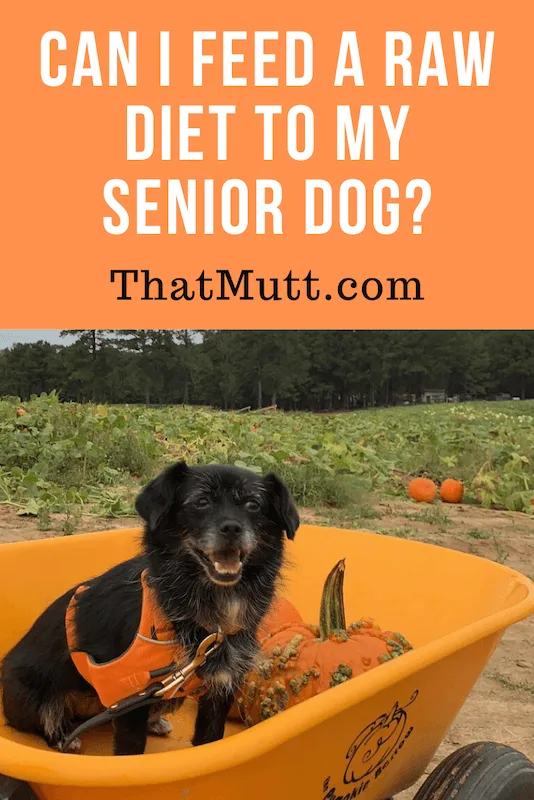
Benefits of a raw diet for senior dogs
I can usually tell a raw-fed dog apart from a dog who eats highly processed food.
The healthier, raw fed dog will have:
- Healthier skin
- Shinier coat
- Cleaner teeth
- Better breath
- Smaller poop volume!
- Strengthened immune system (hopefully reduced risk of cancer)
- Less allergy related ailments
- More energy
- Less or no dog smell
Overall, raw-fed dogs have more energy and are more alert than their kibble-fed counterparts.
See my post: Why I feed my dogs a raw diet.
Downsides of a raw diet for senior dogs:
- Slightly less convenient than scooping kibble out of a bag
- The transition for a senior dog from kibble to raw can take longer than for a younger dog
- Potential higher cost for food (but hopefully fewer vet bills)
It’s never too late to start feeding a senior dog raw food
You may wonder if there’s any point to switching your senior pup over to a healthier, fresh food diet. After all, he’s made it thus far on average dog food, right?
Well, as I just pointed out above, there are several good reasons for making the switch, and dogs of any age will thrive on a more nutritious diet.
You’ll be surprised to see more energy again in your old friend, and who wouldn’t mind better breath and a shinier coat?
I promise you that you have no idea what a soft coat feels like until you’ve touched a raw-fed dog’s coat. The difference is simply drastic.
It’s one I experience every single day when I’m around my dog walking and pet sitting dog clients, many of whom are kibble-fed. In comparison to my dog Wally’s soft coat, theirs looks dull and feels coarse.
Does a senior dog need supplements in his raw diet?
Balanced raw dog food does not require much supplementation. I’ve been feeding raw dog food since 2015 and have only added a handful of superfood supplements such as turmeric paste and raw goat milk.
Check out That Mutt’s article for the short list of supplements I use: Do I Need To Add Supplements To My Dog’s Raw Diet?
That being said, it’s important to understand what balanced raw dog food consists of:
- Muscle Meat
- Secreting Organs
- Raw Meaty Bones
- Some Plant Matter (Veggies and/or fruit)
This might sound a bit confusing at first, but there are two ways of ensuring you get it right.
Option 1: Feed your dog a balanced, pre-made raw food such as Darwin’s
Check out Darwin’s here. Darwin’s is a sponsor of That Mutt, and they offer a pretty good deal for new customers!
I myself started my dogs’ raw dog food journey with pre-made raw from Darwin’s, and they loved and thrived on it.
The only reason why I started making my own raw meals eventually is because it was getting a bit expensive to feed my combined 130 lb dogs (two boxer mixes) this type of raw dog food.
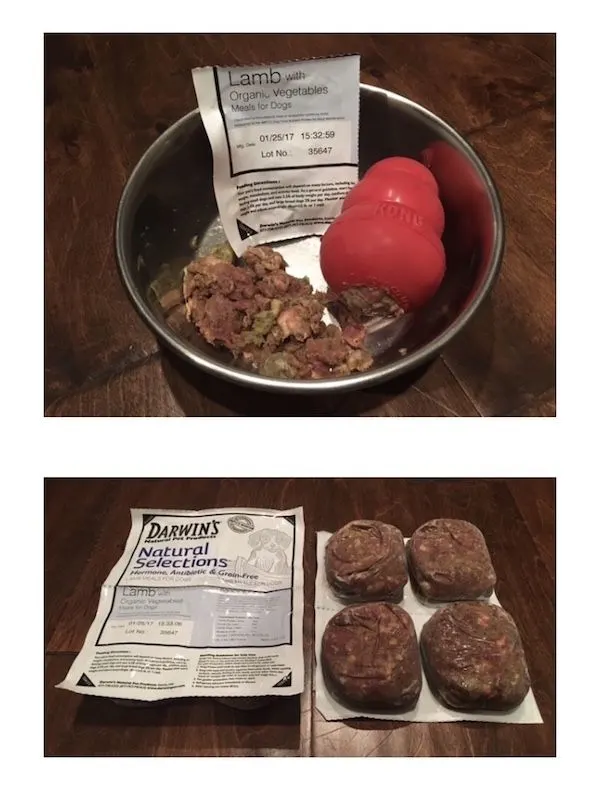
Make your own raw dog food
Just picture a prey animal in the wild, and then recreate it, Frankenstein-style. This method of raw feeding is also called Frankenprey since different animal parts are put together to assemble a whole animal to feed to your dog.
When you’re feeding your dog, keep in mind that you’ll have to rotate the protein sources. This simply means that you shouldn’t feed your dog just one single source of animal. For example, turkey.
That’s because different cuts of different animals contain different nutrients, and a dog in the wild would catch different prey. That dog would eat rabbits, chickens, duck, goose, smaller birds and their eggs, venison, fish, etc. You get the point.
See our post: DIY raw feeding questions
Adding fish to your senior dog’s raw diet
Let me elaborate on fish. Whole fish is great to support your dog’s skin, coat, joint and heart health. That’s because it’s chock-full of manganese, vitamins A, D & E and Omega-3 fatty acids. It also balances the fats in poultry and ruminants.
As such, it’s a lot more efficient than synthetic supplements. You could rotate among the following fish:
- Sardines
- Thread Herring
- Salmon
- Anchovies
- Mackerel
- Smelts
- Green Lipped Mussels (don’t feed if your dog has a known shellfish allergy)
Avoid feeding high level predators like tuna and shark because they contain more heavy metals and toxins than their smaller counterparts. Freeze any fish from the pacific for 3-4 weeks before feeding because they can carry parasites.
Fish oil supplement for senior dogs
If feeding your dog fish isn’t an option, a high quality fish oil will do the trick as well.
I recommend Bonnie & Clyde’s Wild Omega-3 Fish Oil because it’s more concentrated than salmon, pollock, krill and cod liver oil.
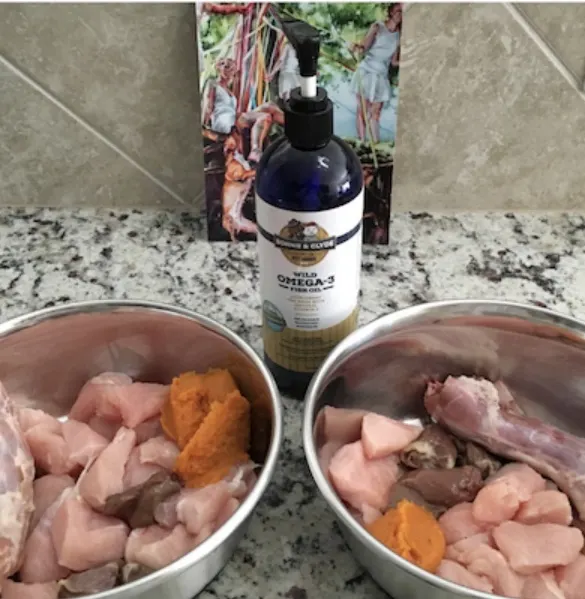
It’s extracted from wild-caught sardines, anchovies and mackerel that are sourced from the South Pacific (Chile and Peru) and off the coast of Africa (Morocco), depending on seasonal availability. It’s manufactured in Iceland.
I’ve alternated between the oil and whole fish before and my pups did very well with both.
How to prevent your senior dog from getting an upset tummy
It’s always best to transition a dog slowly from one type of dog food to another in order to avoid any tummy issues. The same concept applies when making the switch from kibble to raw dog food.
Ideally, you’ll want to do this over the course of 7-10 days to avoid an upset tummy.
Slowly add more raw dog food to your dog’s existing diet until he eventually has nothing but raw in his bowl.
Since you’ll be mixing the two, you’ll want to add a little apple cider vinegar to help your dog’s digestion. That’s because highly processed dog food and raw dog food digest at different rates.
The apple cider vinegar helps make your dog’s stomach more acidic which is what he needs to properly digest the raw dog food and better absorb calcium and other minerals.
A kibble-fed dog’s stomach pH level is more alkaline, around 4 pH and above. Once a dog has been transitioned to raw dog food, his stomach pH level will naturally be more acidic, around 2 pH.
What to do if your senior dog is a picky eater
Did you know that kibble-fed dogs who don’t experience flavor rotation during the first 4-5 months of their life can develop “flavor fatigue” meaning they turn into picky eaters?
There are a few options of enticing a picky eater to eat their raw dog food. Remember, dogs who are “kibble junkies” have to be weaned off the synthetic ingredients and palatants they’ve been eating for years.
Some dogs (like most greedy Labradors!) will eat anything and can be transitioned very easily.
Other dogs, particularly smaller breeds, can be more difficult to convince to eat something different.
The following tips can help you transition your picky eater from kibble to raw dog food:
- Gently cook the raw meat for a few weeks. Then, slowly decrease the level of cooking until you can serve the meat raw.
- Never cook bones. Once you do, the bone density changes and the bone becomes brittle. That’s when it can splinter and cause damage in your dog’s throat and/or digestive system.
- Top the raw meat off with puréed veggies and/or fruit. You’ll want to purée the plant matter because dogs lack the enzyme that’s responsible for breaking down plant cell walls. That’s why we need to do it for them to ensure they’re able to absorb the maximum of nutrients from the plant matter.
- Add raw goat milk or bone broth to your dog’s raw meat. You can try warming it up a little as well.
- Warm up some water and add it to your dog’s raw meal. It’ll bring out the flavor.
Transitioning my senior dog to a raw diet – Lila the Pekingese mix

I’m currently working on making the transition from kibble to raw dog food for my roommate’s dog Lila. She’s a 10 ten year old, 15-lb Pekingese mix who’s very particular about her food.
I first tried to offer her a bowl of pre-made raw dog food from a variety of brands.
I tried Stella & Chewy’s, Steve’s Real Food, Primal Pet Foods and Instinct Raw. She politely sniffed the contents of her bowl and that was it.
I also tried to just give her a few bites of raw ground turkey and beef from the grocery store, but the results were the same. She showed some interest, but didn’t eat it.
The approach I’m taking with Lila right now is to gently cook her raw meat.
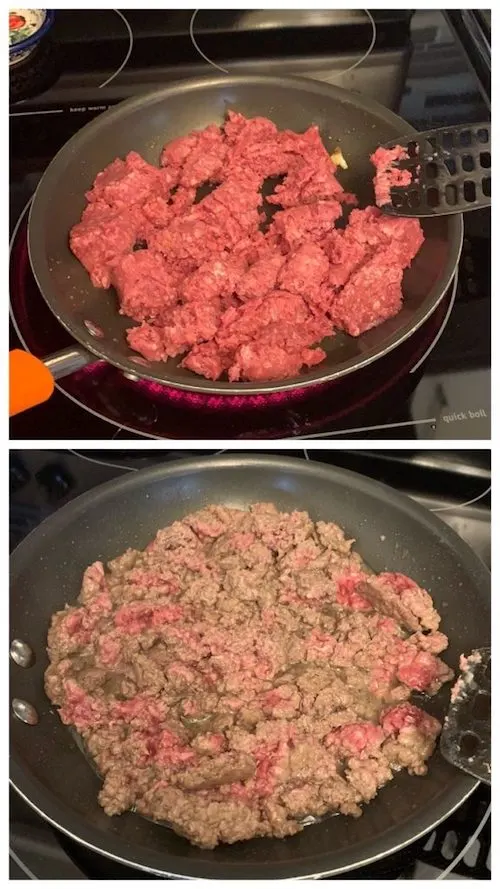
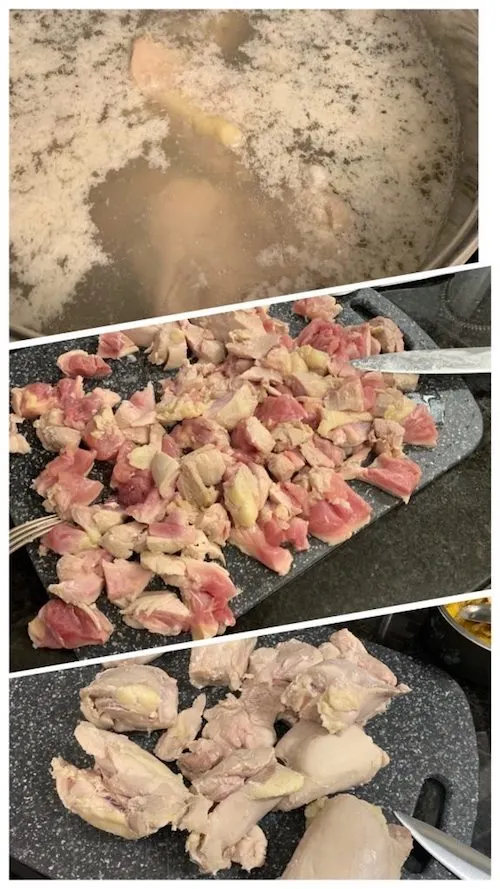
I’ve been able to successfully sneak a little raw food to her meals.
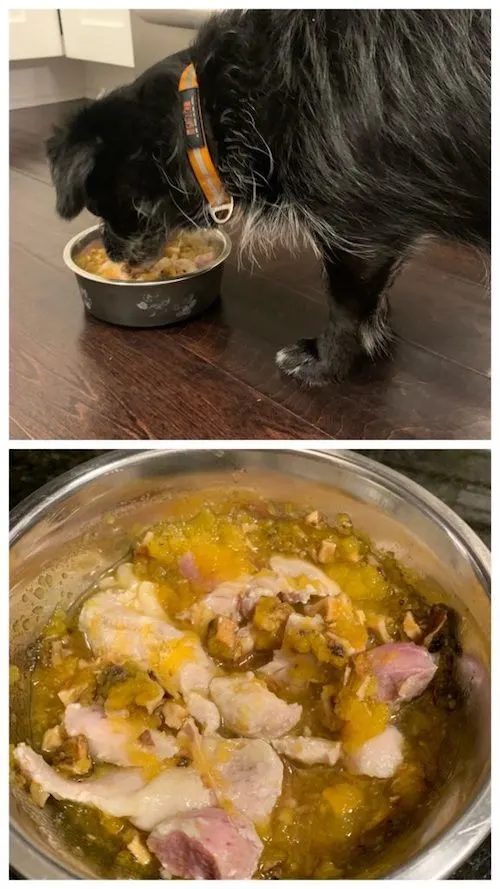
She’s also been eating air-dried meaty bones like chicken necks and feet, as well as air-dried sardines. That combination ensures that her meals are balanced and nutritious.
Remember: A balanced raw dog food diet includes:
- muscle meat
- secreting organs (see where to buy organ meat here)
- meaty bones
- plant matter
I’m hoping that Lila will eventually eat 100% raw meals, but even if she ends up preferring lightly cooked meals, she’ll still be healthier than she was on kibble.
I’ve already seen and felt an improvement in her coat compared to what it looked and felt like when she ate highly processed dog food.
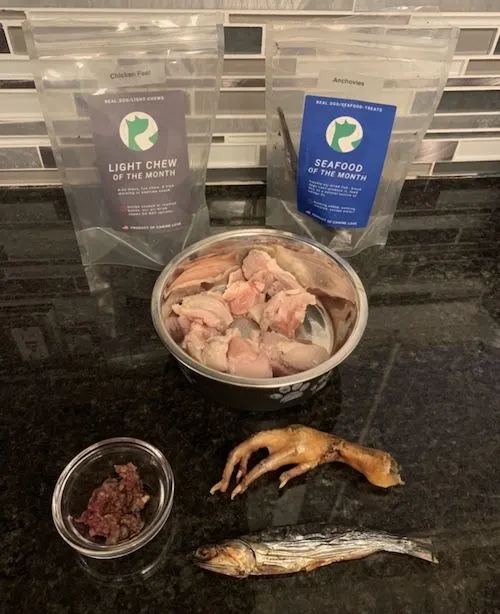
Tip: Feed ground bones if your senior dog has bad teeth
Raw meaty bones are an integral part of a balanced, raw meat diet for dogs and are known as “Mother Nature’s toothbrush” because the action of chewing them cleans the dog’s teeth.
See our post: How to safely feed your dog raw bones.
That being said, some senior kibble-fed dogs may have bad or weak teeth. That’s because their teeth usually don’t get brushed on a regular, daily basis to ensure that food residue can’t accumulate on their teeth and transform into plaque.
Those dogs may not be able to properly chew raw meaty bones. Yet, they’ll still need to consume them because calcium and phosphorus content is essential for a dog’s strong bones and joints.
The solution for this dilemma is to grind your dog’s raw meaty bones. You can either do this yourself with a powerful meat grinder like the Weston Butcher Series #32.
Another option is to stick with pre-made raw meals from a brand like Darwin’s Natural Pet. Food from Darwin’s consists of ground muscle meat, secreting organs, raw meaty bones and veggies.
Now we’d like to hear from you!
Now it’s your turn! Have you transitioned your senior dog to a raw meat diet? Do you have any additional advice?
If you have any questions, let us know in the comments!
Barbara Rivers writes regularly for That Mutt. She is certified in raw dog food nutrition from Dogs Naturally Magazine and the author of three ebooks about balanced raw dog food. She is a blogger at K9s Over Coffee.


NormanWilkes
Monday 24th of February 2020
Very well said. A wonderful article with a lot of good information to know!
Barbara R.
Tuesday 25th of February 2020
Thanks, Norman!
Daniel
Monday 24th of February 2020
Interesting read. One can tell the this almost scientific article is written by someone who knows what she’s talking about. I enjoyed the straight forward DIY handy hints.
Barbara R.
Tuesday 25th of February 2020
Thank you, Daniel. I'm happy to hear that you found my words interesting!